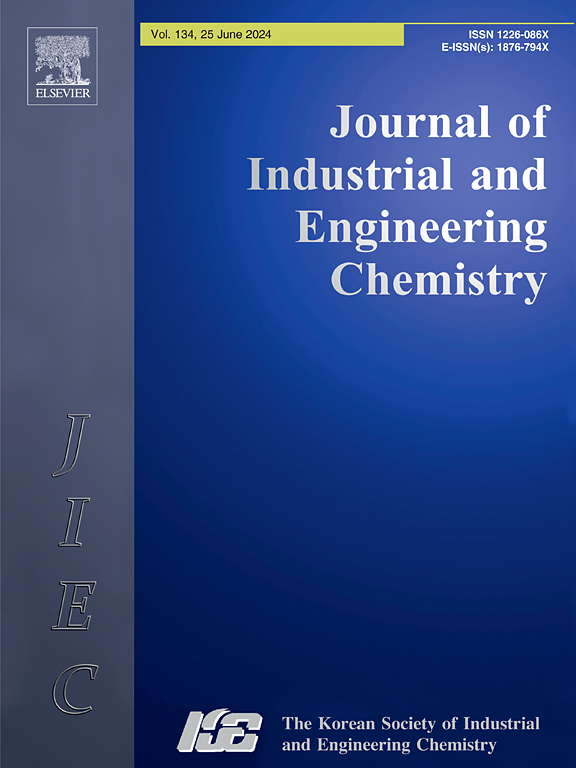Photocatalytic degradation of rhodamine B dye using PEG@ZnS:Au and PVP@ZnS:Au nanoparticles
IF 5.9
3区 工程技术
Q1 CHEMISTRY, MULTIDISCIPLINARY
Journal of Industrial and Engineering Chemistry
Pub Date : 2024-11-26
DOI:10.1016/j.jiec.2024.11.045
引用次数: 0
Abstract
The textile industry significant contribution to water pollution necessitates the development of innovative solutions for efficient wastewater treatment. This study reports the successful synthesis of PEG@ZnS:Au and PVP@ZnS:Au nanoparticles via co-precipitation method, characterized by a suite of analytical techniques including photoluminescence (PL), Brunauer-Emmett-Teller (BET) analysis, scanning electron microscopy (SEM), transmission electron microscopy (TEM), Fourier transform infrared spectroscopy (FTIR), and X-ray diffraction (XRD). The photocatalytic activity of the synthesized nanoparticles was evaluated, revealing that PEG@ZnS:Au and PVP@ZnS:Au nanoparticles degraded 94.25 % and 91.45 % of rhodamine B dye, respectively, within a 30-minute timeframe, showcasing their exceptional catalytic performance. Kinetic studies revealed pseudo-first-order behavior, conforming to the Langmuir isotherm model, with an endothermic adsorption process. The degradation process is mediated by forming reactive oxygen species (ROS), which are generated by electron-hole pairs upon photoexcitation. This research underscores the potential of nanoscale materials for enhanced photocatalysis. It provides valuable insights into developing efficient wastewater treatment strategies, highlighting a promising approach for mitigating the environmental impact of textile industry effluents.
利用 PEG@ZnS:Au 和 PVP@ZnS:Au 纳米粒子光催化降解罗丹明 B 染料
纺织业对水污染的影响很大,因此有必要开发创新的解决方案来高效处理废水。本研究报告通过共沉淀法成功合成了 PEG@ZnS:Au 和 PVP@ZnS:Au 纳米粒子,并采用了一系列分析技术,包括光致发光 (PL)、Brunauer-Emmett-Teller (BET) 分析、扫描电子显微镜 (SEM)、透射电子显微镜 (TEM)、傅立叶变换红外光谱 (FTIR) 和 X 射线衍射 (XRD)。对合成纳米粒子的光催化活性进行了评估,结果表明,PEG@ZnS:Au 和 PVP@ZnS:Au 纳米粒子在 30 分钟内分别降解了 94.25% 和 91.45% 的罗丹明 B 染料,显示了其卓越的催化性能。动力学研究揭示了伪一阶行为,符合朗缪尔等温线模型,吸附过程为内热。降解过程是通过形成活性氧(ROS)来介导的,而活性氧是由电子-空穴对在光激发时产生的。这项研究强调了纳米级材料在增强光催化方面的潜力。它为开发高效的废水处理策略提供了宝贵的见解,为减轻纺织工业废水对环境的影响提供了一种前景广阔的方法。
本文章由计算机程序翻译,如有差异,请以英文原文为准。
求助全文
约1分钟内获得全文
求助全文
来源期刊
CiteScore
10.40
自引率
6.60%
发文量
639
审稿时长
29 days
期刊介绍:
Journal of Industrial and Engineering Chemistry is published monthly in English by the Korean Society of Industrial and Engineering Chemistry. JIEC brings together multidisciplinary interests in one journal and is to disseminate information on all aspects of research and development in industrial and engineering chemistry. Contributions in the form of research articles, short communications, notes and reviews are considered for publication. The editors welcome original contributions that have not been and are not to be published elsewhere. Instruction to authors and a manuscript submissions form are printed at the end of each issue. Bulk reprints of individual articles can be ordered. This publication is partially supported by Korea Research Foundation and the Korean Federation of Science and Technology Societies.

 求助内容:
求助内容: 应助结果提醒方式:
应助结果提醒方式:


